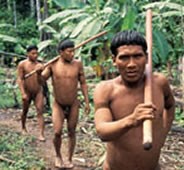Korubo in Brazil

Photo Source:
Copyrighted © 2026
Etnopedia All rights reserved. Used with permission |
Send Joshua Project a map of this people group.
|
| People Name: | Korubo |
| Country: | Brazil |
| 10/40 Window: | No |
| Population: | 50 |
| World Population: | 50 |
| Primary Language: | Korubo |
| Primary Religion: | Ethnic Religions |
| Christian Adherents: | 0.00 % |
| Evangelicals: | 0.00 % |
| Scripture: | Translation Needed |
| Ministry Resources: | No |
| Jesus Film: | No |
| Audio Recordings: | No |
| People Cluster: | South American Indigenous |
| Affinity Bloc: | Latin-Caribbean Americans |
| Progress Level: |
|
Introduction / History
The Korubo tribe was first contacted near the end of the 19th century. They speak Panoan. They have had violent confrontations with nearby groups and also killed trespassers on their land. They are called Caceteiros by their neighbors, a term which means "men with clubs."
The Korubo live in the lower Javari Valley in Brazil's Amazon Basin.
What Are Their Lives Like?
The Korubo have a little knowledge of agriculture. Instead, they hunt with clubs and poison darts. They eat fish, spider monkeys and wild pigs as well as corn.
Like many peoples in this region, the men and women are painted with red dye. Their hair is cut as if a bowl had been placed over their heads. They live in community huts. On a few occasions they have practiced infanticide, sometimes as a sacrifice. Malaria has killed some of them.
What Are Their Beliefs?
They do not appear to be religious, though they have their own beliefs.
What Are Their Needs?
After an argument the tribe separated in two groups. The smaller group has contact with others, but the larger group is isolated. The Brazil authorities are trying to prevent contact with them.
Prayer Points
Pray for the Lord to shower his abundant mercy on the Korubo people.
Pray against the Korubo using violence and infanticide, and that they will be contacted peacefully.
Pray for them to have an awakening of the Holy Spirit to the centrality of worshiping their creator.
Pray for the Holy Spirit to give their elders Christ-centered dreams and visions.